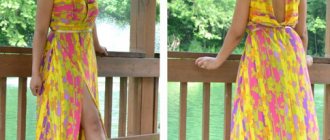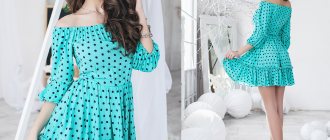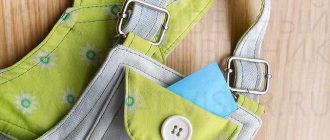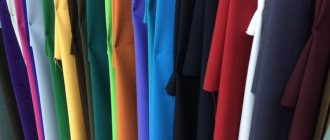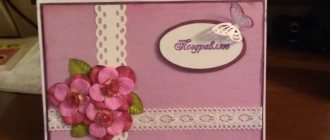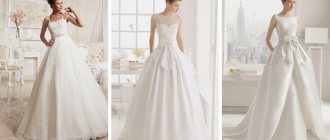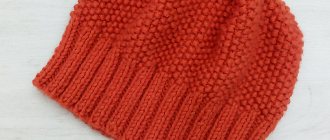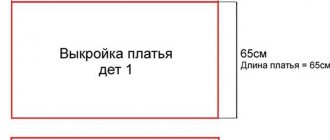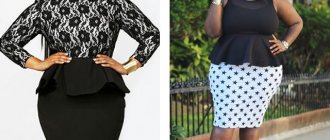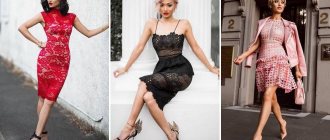The laconic sheath dress came into fashion at the beginning of the last century and has not left the ladies’ closet since then. Its main feature is the cut, which “outlines” the figure and tapers downwards. “Sheaths” most often have a round neckline and no sleeves. However, over the many years of its existence, the dress has changed and become more practical. So, today the style of sheath dress with sleeves is especially popular, the pattern of which is presented in this article. This model, if paired with appropriate accessories and shoes, is equally suitable for work, an evening out and everyday wear. By the way, “cases” were the favorite outfits of such famous women as Audrey Hepburn and Jacqueline Kennedy.
In addition, a sheath dress is a basic pattern that can be used to model other dress options in the future. Today I propose to study how to create a dress pattern according to your figure, as well as ready-made patterns and several drawings with calculations.
Knitted dress with long sleeves
To sew a dress you need to prepare:
- knitted fabric;
- trim for decoration;
- threads, sewing tools.
Description
Dress bodice pattern without darts
As a basis for modeling, we will use a basic knitwear dress pattern.
Considering that knitwear stretches easily and under the influence of the weight of the skirt the waist line can move down, we obviously raise it by 5 cm.
We reduce the depth of the armhole by raising its lower level by 2 cm. We extend the line of the side seam.
We expand the neckline on the back, drawing the desired contour at a distance of 2 cm from the original one.
On the front bodice pattern, we widen the cutout by 2 cm along the shoulder line and measure down 19 cm along the center line. Draw a straight roll-out line.
On the patterns we mark the direction of the grain thread, which should coincide with the middle lines of the front and back bodice.
We remove unnecessary lines.
We transfer the contours of the parts to a new sheet of paper.
We provide an allowance of 1 cm along the roll-out, armhole, side and shoulder seams, and 2 cm along the bottom edge.
Cut out the bodice of the dress
Fold the fabric in half with the right side inward, aligning the fold line with the direction of the grain thread. We place the front and back bodice patterns with the middle seam on the fold line.
Sleeve pattern
Let's create a basic sleeve pattern. In our model, the sleeve is made on the cuff. Accordingly, we calculate the length of the sleeve as the length of the sleeve according to the measurement (from the shoulder point to the hand) minus the width of the cuff (= 3 cm) and plus 2 cm for a loose fit.
We mark alignment marks on the sleeve cap and armhole lines. We transfer the contours of the pattern to a new sheet, draw allowances along the edging and sleeve seam of 1 cm, along the bottom edge of 1-2 cm.
Draw a perpendicular from the top of the collar to the bottom line of the sleeve. Divide the distance from it towards the front bodice to the seam into three parts. We make a cut along the line of the first third. We expand the pattern, expanding it along the lower edge by 8 cm. We remove the expanded pattern onto a new sheet or fix the expansion with tape.
If desired, the bottom of the sleeve can be made more flared. To do this, we make a larger number of vertical cuts on the pattern and evenly move the sections apart.
When constructing, do not forget to outline the direction of the shared thread. It coincides with the virtual center line of the pattern.
We need to cut out two sleeve parts from the fabric.
In addition to the details listed above for the knitted dress pattern, we also need to cut out:
- skirt panels: two rectangles with a height equal to the length of the product from the waist line to the bottom edge plus 2 cm for the allowance along the top edge and plus another 4 cm for the allowance along the bottom edge, a width equal to the POB plus 15 cm for gathers and plus another 2 cm for side seams. The patterns must be placed on the fabric so that the grain thread is perpendicular to their height;
- cuffs: two rectangles with a height equal to 8 cm (= 3 cm x 2 + 2 cm) and a length equal to the width of the lower cut of the sleeve plus 2 cm for allowances. When cutting, the grain thread should be parallel to the length of the workpiece. The length of the decorative trim is equal to the length of the cuff blank;
- facing for rolling out the neck: a strip 5 cm wide (= 1.5 cm x 2 + 2 cm) and a length equal to the length of the neck (we measure the front and back bodice using the patterns; for stretchy fabrics it is reduced by 1-2 cm) plus 2 cm for allowances. In this case, the grain thread should be parallel to the length of the workpiece;
- nameplates: three rectangular pieces with a width equal to the width of the binding and a height equal to 14 cm (6 cm x 2 + 2 cm).
How to sew a knitted dress with sleeves
Fold the front and back bodice pieces right sides together, stitch along the side seams and along the shoulder lines. We process the seam allowances with an overlocker.
We process the neck sections with a facing.
We make vertical seams on the sleeves. Using an overlocker, we process the cuts at the allowances. We sew the sleeves into the armholes and overcast the edges.
Next, we will process the lower sections of the sleeves. We turn over one hem of the binding and iron it. We place the binding on the cuff with right sides facing each other, and sew the parts together using a machine seam. The stitching should not go beyond the cuff allowance. Next we work with the cuff and trim as one piece. Fold and stitch along the vertical edge. We turn the allowances in different directions and iron them. Bend the piece in half.
We put the cuff with the trim down on the front side of the sleeve, aligning the seams and cuts. We sew the parts together using a machine seam, and overcast the edges of the allowances.
Next, we sew the skirt panels along the vertical seams and process the cuts. At a distance of 1 cm from the top edge, sew a long stitch (= 4 mm), leaving long threads along the edges of the seam. 2 cm from this seam we make another similar one. Gather the top of the skirt evenly by pulling the ends of the threads. The circumference of the top section of the skirt should be equal to the circumference of the bottom section of the bodice. We sew together the bottom and top parts of the dress, aligning their side seams. To do this, we perform a knitted stitch, departing 2 cm from the edge. We process the sections with an overlocker.
Fold the bottom edge of the dress twice to a width of 2 cm and stitch.
Next, we will make belt loops from the tape. Without ironing it, we grind it into a ring. Iron the seam allowances. Fold the ring in half, placing the stitching seam in the center of the wrong side of the belt loop. We sew along the length with straight seams, departing from the edges by 2 mm.
Along the middle line of the belt blank, we attach the trim with straight seams, retreating 2 mm from each edge. We bend the belt blank in half along the long side with the front side inward. Sew along the end and long side. Turn the piece right side out and sew the open end together using a hand blind stitch.
Mark the position of the belt loops on the side seams and the center of the back. The top edge of the belt loops should be 4 cm above the waist line, the bottom edge 2 cm below the waist line. We sew the belt loops by hand.
The dress is ready!
Season and purpose
The purpose of the clothing is determined by the style. The more exposed your upper body is, the easier the event should be. In strict versions, small cuts are made in the cut in the shoulder area so as not to spoil the image.
Dresses with open shoulders are not suitable for the winter season. Exceptions include parties in warm rooms. Mostly such outfits are worn in the summer. For the spring-autumn season, products complemented with fur or woolen capes, made in the same style or color scheme as the dress, are suitable.
Ready-made patterns for knitted dresses with sleeves
Patterns are made for several sizes:
- size 48 (OG – OT – OB): 106-90-112 cm;
- size 50 (OG – OT – OB): 110-94-116 cm;
- 52 sizes (OG – OT – OB): 114-98-120 cm;
- 54 sizes (OG – OT – OB): 118-102-124 cm;
- Size 56 (OG – OT – OB): 122-106-128 cm.
You can choose the right size by checking the measurements provided.
Dress with lantern sleeve
The model is made with a cut-off bodice and a stand-up collar, decorated with a flounce at the bottom. There is a fastener in the center of the front.
For modeling, a pattern of a straight dress with a fitted silhouette is used as a basic pattern.
We increase the length by the size of the shuttlecock, cut the pattern along the waist line. We draw a pattern line for the yoke. We measure the required sleeve length and draw a line on the pattern.
Back
On the back pattern, we remove the shoulder dart by cutting off its solution from the armhole. The waist dart on the bodice is made in the form of one fold. We divide the solution of the waist dart on the skirt in half into two folds.
Before
Cut off the yoke along the drawn line. We extend the center line of the chest dart to the yoke, and make a cut along the axis of the dart. Let's close it. Along the middle line of the shelf we lower the waist line by 1 cm. We make the waist dart on the bodice in the form of one fold. We divide the solution of the waist dart on the skirt in half into two folds. We draw a bar for the fastener.
Sleeve
We measure the height of the cuff on the flashlight sleeve pattern and cut it off. We cut the rest of the pattern into several sections and spread them to the desired width. We retake the pattern of the flared sleeve, creating a smooth edging line.
For the shuttlecock, the original rectangular patterns must first be flared on the sides and the cut lines must be marked. Cut along them and move the sections apart.
Collar
We determine the roll-out length by measuring, and create a pattern for the stand and collar.
Modeling of a dress with a lantern sleeve is completed. When cutting we need to cut:
- back - 2 parts;
- back panel of the skirt - 2 parts;
- front panel of the skirt – 1 piece with a fold;
- yoke - 2 parts;
- strips - 2 parts with a bend;
- front – 2 parts;
- sleeve – 2 parts;
- cuff - 2 parts;
- collar – 2 parts with a fold;
- stand - 2 parts with a bend;
- flounce of the front part of the skirt - 1 part with a fold;
- flounce of the back part of the skirt - 1 part with a fold.
Fabric selection
To begin with, we note that the market for modern knitted fabrics is simply huge. The material has different texture, density, composition, plasticity, elasticity, extensibility and knitting density. There are so many options that it makes no sense to even list them in this lesson.
It is clear that it is impossible to create a universal pattern for all types of knitted fabrics, so we will analyze some average option, taking into account the main property of knitwear - stretchability. For the master class, we selected a fabric with 50% elasticity, that is, every ten cm of material stretches up to fifteen cm, while the external appearance of the fabric will remain neat.
Stylish floor-length chiffon dress with puff sleeves
For this model of a dress with sleeves, the detail patterns are modeled on the basis of a straight dress with a fitted silhouette.
We cut the patterns along the waist line.
On the front bodice pattern, draw a line from the top of the dart to the armhole.
We close the chest dart by first cutting the pattern along the drawn line.
Close the dart at the waist in the same way.
We shorten the chest dart by moving its center by 2 cm for girls with an average breast size and by 3-4 cm for those with large breasts. We provide seam allowances.
We make the skirt pattern longer by the required amount.
From the bottom point of the dart, draw a vertical line and cut the pattern along it. Close the dart at the waist by spreading the lower sections.
Along the bottom edge we increase the flare by drawing a new side seam line.
In the area between the dart and the side seam, draw a straight line (see drawing) and cut the pattern along it. We spread the pattern to expand it into gathers.
We retake the extended pattern and provide seam allowances.
We will construct a pattern for a flashlight sleeve based on a pattern for a straight one-seam sleeve.
We measure the circumference of the wrist. We narrow the length of the lower cut of the sleeve to this size. Divide the pattern into four sections of equal width using vertical lines.
Shorten the sleeve to three-quarter length.
We cut the sleeve pattern into several parts along the width. We push apart until each cut has an additional 2-3 cm of rim for gathering.
Raise the edge by 5-7 cm, draw a new line for the edge.
We provide allowances along the vertical seam of the sleeve of 1.5-2.0 cm, on the upper cut 0.5-1.0 cm, on the bottom - 3-5 cm.
The dress pattern with a lantern sleeve is ready!
Popular styles
Fashion designers are democratic in their selection of styles. They offer many options.
Dress with open shoulders and sleeves - popular styles
But most often found in collections are:
- shirt dresses. Current use – beach parties or walks around the city;
- trapezoids. An excellent choice for girls and women whose figure does not look the best;
- long sundresses. Thanks to the professional decor of this style, sundresses do not look simple, and are suitable even for important events;
- with fluffy skirts. This is a youth format that does not hinder movement;
- year. It is very similar to the mermaid style and is perfect for an evening event.
Ready-made dress patterns with puff sleeves
Patterns are made for several sizes:
- size 36 (OG – OT – OB): 82-66-88 cm;
- size 38 (OG – OT – OB): 86-70-92 cm;
- size 40 (OG – OT – OB): 90-74-96 cm;
- 42 sizes (OG – OT – OB): 94-78-100 cm;
- 44 sizes (OG – OT – OB): 98-82-104 cm;
- size 46 (OG – OT – OB): 102-86-108 cm;
- size 48 (OG – OT – OB): 106-90-112 cm;
- Size 50 (OG – OT – OB): 110-94-116 cm.
You can choose the right size by checking the measurements provided.
Dress "Peasant Woman"
The simple pattern of this model without darts or fasteners is ideal for beginning seamstresses.
To sew a dress you need to prepare:
- fabric - chintz, cambric, satin - 2 m or more (depending on the length of the dress);
- narrow elastic band;
- threads, sewing tools.
Description
Constructing a pattern
We need measurements:
- line of blades (LL) – 16.5 cm;
- chest line (LH) – 22.5 cm;
- back waist length (DTS) – 39 cm;
- back width, 1⁄2 measurements (ШС) – 1⁄2 35 cm = 17.5 cm;
- back shoulder slope (BSS) – 36 cm;
- chest height (CH) – 24.5 cm;
- armhole width (SHR) – 9 cm;
- front waist length (accident) – 42 cm;
- front shoulder slope (FST) – 23 cm;
- side length (DB) – 1.5 cm – 20 – 1.5 cm = 18.5 cm;
- chest width 1st (1/2 measurement) (WG1) – 38:2 = 19 cm;
- chest width 2nd (1/2 measurement) – 34: 2 = 17 cm;
- dart opening level (URL) – 7.5 cm;
- center of the chest (1/2 measurement) (RC) - 19: 2 = 9.5 cm;
- neck circumference (1/2 measurement) (SS) – 30: 2 = 15 cm;
- chest circumference (1/2 measurement) (SG) – 82: 2 = 41 cm;
- shoulder length (L) – 13 cm.
The illustrations below show how to correctly take these measurements.
When modeling, we take into account the increase in loose fit of 8 cm. We distribute it on ShS and ShG1 by 1.5 cm, on ShPr - 5 cm.
In the upper right corner of the sheet, mark the point (∙) P and construct a right angle from it. Vertically down from (∙) P we put LL + 0.5 cm. Then further sequentially along the same straight line RL = 16.5 + 0.5 cm = 17 cm, LG + 0.5 cm, RG = 22.5 + 0.5 cm = 23 cm, DTS + 1 cm, RT = 39 + 1 cm = 40 cm. Through (∙) G and (∙) T we draw horizontal lines. From (∙) T we set aside TT1 = 2.5 cm. We connect (∙) L and (∙) T1 with a straight line. At its intersection with the chest line we mark (∙) G1.
From (∙) L to the left side we put aside the value LL1 = ШС + 1.5 cm = 19 cm. Draw a vertical straight line down from (∙) L1. At its intersection with the chest line we mark (∙) G2. From it we set aside the width of the armhole G2G3 = 14 cm. In the center of the segment G2G3 we mark (∙) O. We draw a vertical straight line from it to the waist line. Mark (∙) T2. From this (∙) we put up T2O3 = DB – 3.5 cm = 15 cm.
From (∙) P to the left side we put PP1 = 1/3 SN + 1.5 cm = 6.5 cm. From (∙) P1 we draw an arc with a radius of DPl + 0.5 cm = 13.5 cm. From (∙) P1 T1 we draw an arc with a radius of NPS + 1 cm = 39 + 1 cm = 40 cm. At the intersection of the arcs we mark (∙) P. We draw the segment P1P.
From (∙) Г3 to the left we construct the segment Г3Г4 = ШГ1 + 1.5 cm = 20.5 cm. From (∙) Г4 vertically upward we plot the value Г4Р2 = ВГ + 0.5 cm = 25 cm. From (∙) Р2 along vertically down we lay down the segment P2T3 = accident + 1 cm = 43 cm. Connect (∙) T2 and (∙) T3 with a straight line.
From (∙) P2 to the right side we construct a segment P2P3 = PP1 = 6.5 cm. From (∙) P3 to the right we set aside 5 cm, put (∙) P4. From it downwards we set aside the slope of the shoulder 1 cm, set (∙) P5. Draw the segment P5 P3.
From (∙) G4 to the right side we put RC = 10 cm. We connect (∙) Ts with (∙) P5. From MC we lay off CU = URV + 0.5 cm = 8 cm. With a radius equal to the difference SHG1 – SHG2 = 19 cm – 17 cm = 2 cm from (∙) Y we draw an arc. We draw the second arc from (∙) C with a radius of URV + 0.5 cm = 8 cm. At the intersection of the arcs we place (∙) U1. From (∙) C through U1 we draw a segment CR5, mark (∙) P6. We built a bust dart.
From (∙) Р6 we draw an arc with a radius ДПл – Р4Р6 – 5 cm + 0.5 cm = 4.5 cm. From (∙) Ц we draw a second arc with a radius NPP + 0.5 cm = 23.5 cm. At the intersection of the arcs we place (∙) P1. Draw the segment P1P6.
To construct control points of the armhole, from (∙) P1 to the left side we draw a straight line, from (∙) G3 we draw a vertical straight line upwards. At the intersection of these lines we put (∙) A. From (∙) G3 we measure up a third of the length of the segment G3A, and put (∙) O4. We draw the pattern line of the armhole through (∙) P1, (∙) O4, (∙) O3.
From (∙) G2 we set aside G3O4 + 1...2 cm, put (∙) O5. From it to the left we measure 1 cm, put (∙) O6. We draw the pattern line of the back armhole through (∙) P, (∙) O6, (∙) O3.
We created a pattern for the back and front of the dress. To draw the line of the lowered shoulder, we measure the distance to the new rollout. We measure the value from the 7th cervical vertebra to the required depth. For us, this size is 10 cm. From (∙) P, measure down this size, put (∙) K. From this (∙) to the left side, draw a straight line to the back armhole, put (∙) K1. Raise this (∙) along the armhole by 1-2 cm, mark (∙) K2. We draw a pattern line KK2.
From (∙) P2 we measure down 10 cm, mark (∙) K3. From it to the right side we draw a straight line to the front armhole, mark (∙) K4. Raise this (∙) by 1-2 cm, draw a pattern line to K4. We remove the lines of the chest dart.
The bodice pattern for the “Peasant Woman” dress is ready.
How to sew
We place the patterns on the fabric folded in two layers with the wrong side up. Place the center line of the pattern on the fold of the fabric. We retreat 7-8 cm from the top layer. We cut out the parts with an allowance of 1 cm, along the neck we provide an allowance of 6 cm.
We will create the sleeve pattern directly on the fabric. To do this, we cut out two rectangular blanks of the required width and length.
We will cut a 3⁄4 sleeve. Its length is 45 cm + 2 cm (allowance along the bottom edge) + 6 cm (allowance along the top edge) = 53 cm. The width of the sleeve is calculated as the sum of the arm circumference + 3-4 cm for a loose fit + 2 cm for allowances + 30 cm for assemblies.
We fold the fabric in two layers with the right side inward. We place the pattern on the side cut of the sleeve, retreating 1 cm from the edge and 7-8 cm from the top. We mark the outline of the front armhole from (∙) O3 to the end of the front armhole. At (∙) O3 we make a notch on the material.
Turn the sleeve over to the other wrong side. We focus on the notch and place the pattern on the side cut of the sleeve at a distance of 1 cm from the edge. Draw the back armhole from (∙) O3 to the end of the back armhole.
We unfold the sleeve and draw a smooth line along the inside, connecting the extreme points of the armhole and the front. We design the lower section of the sleeve with a smooth line. We cut out the sleeve with an allowance of 6 cm along the upper edge and 2 cm along the lower edge. We cut the second sleeve in the same way.
The skirt for the “Peasant Woman” dress can be made simply straight, with frills or sun-flared.
We also determine the length according to our wishes. This dress looks great with both midi and maxi lengths. The dress cannot be made too short; it will not be harmonious for such a style.
We process the cuts of the workpieces with an overlocker. We make sleeve seams and iron the allowances.
We make two folds along the lower edge of the sleeves and stitch them.
When sewing, leave a small area open for threading the elastic.
We sew the sleeves into the armholes and iron the allowances.
We get an almost finished upper part of the dress.
On the skirt we process the allowances with an overlocker. We machine stitch along the top edge at a distance of 1 cm from the edge. Make the stitches on the line as large as possible. By pulling the threads, we gather the skirt to a width equal to the length of the lower sections of the upper part of the dress.
We machine stitch the skirt to the top of the dress, turn the allowances towards the bodice and iron them.
Turn the product inside out and fold it, aligning it along the seam at the waist.
Sew the middle seam on the back and skirt, ironing the seam allowances.
Along the rollout of the neck we make a turn of 5 mm, then another of 4 cm.
We sew along the edge of the hem, leaving an open area for threading the elastic. Then we make a second seam parallel to the first at a distance of 1.5-2.0 cm from it. Iron the seams.
If, when trying on, it turns out that the sleeves are too wide, then along their upper edge we sew two lines between the armholes of the back and front. We make the first seam slightly below the stitching, the second - slightly above the seam for the drawstring. It is important not to touch these seams.
We tighten the threads of the seams, evenly gathering the sleeve.
The described operation will prevent the wide sleeve from moving along the elastic band. We process the second sleeve in the same way.
For the waist drawstring, we will cut out a rectangular blank with a width of 2.5-3.0 cm + 2 cm (allowances) and a length equal to the length of the waist, measured along the dress + 2 cm (allowances). We sew the drawstring along the wrong side onto the waist seam, closing it. At the same time, we tuck the edges of the drawstring.
We attach a drawstring along the front side, sewing a line into the seam of the skirt and bodice. Along the wrong side we sew the upper edge of the drawstring, leaving a small open area for threading the elastic. Iron the seams.
Determine the desired length of the elastic for the sleeves, rollout and waist. We thread it through the drawstrings. We sew up the open areas by hand using a blind stitch.
Fold and stitch the bottom edge of the dress. We can make a belt upon request. Iron the product.
How to wear chiffon correctly
Rules:
- In some cases, it is better to wear a white, flesh-colored T-shirt under the dress.
Nude underwear
- It is better to choose loose-fitting dresses, since chiffon should flow and fall down, and not hug the body.
- It is important to carefully consider the look from underwear to accessories.
Multi-layered image
- Since chiffon is transparent, it is recommended to wear nude underwear under dresses.
Important! Girls often think that it is more correct to wear white underwear, but it looks vulgar and attracts the attention of passers-by.
Girl at the fashion show in a chiffon dress
- It is also better to choose smooth underwear for a chiffon dress, leaving lace items for another occasion.
Full image
- Experiment with the image. For example, in 2021, layered looks with different combinations of fabric types, colors and accessories are popular.
Accessories for a dress
The main thing is to feel confident in the chosen look. Products made from this material are suitable for girls of any body type, as the flowing fabric visually stretches the image and hides imperfections.
Dress "Peasant Woman" without a pattern
You can sew a dress without a pattern by cutting out the details directly on the fabric. A dress diagram for sizes 44 - 56 is proposed.
The total width of the product is 1.4 m. The sleeve length can be adjusted as desired.
To sew such a dress, you need to prepare a piece of fabric with a length equal to the length of the dress plus the sleeve length. If you want to sew a flared version of the model, you must first make a dress pattern on paper.
Then mark the cutting lines.
We cut the pattern and spread it to the required size.
Material
You need to be careful when choosing materials. Some fabrics are not suitable for the desired style, add or remove age, highlight or disguise imperfections. Designers advise not to focus on fashion trends, but to take into account individual characteristics when choosing.
Dress with open shoulders and sleeves - lace, cotton, chiffon, knitted
Fashionable materials in 2020-2021 are:
- lace. Such fabrics look cute only on young girls. Older women should avoid them. Such products make you look younger, but too much so that it looks ridiculous and comical;
- cotton There are plenty of options for this material. It is considered universal because it is suitable for any style and age. These are natural fabrics, so they can be used to sew dresses for little girls;
- chiffon. This fabric can be combined with other materials because it is transparent. Usually they make a guipure or silk dress, and a chiffon cape;
- knitted These dresses fit perfectly on the figure, so they are not suitable for women with shortcomings. They also do not create elegant looks, so they are used in everyday life. For evening events, it is better to choose other fabrics.
A-line dress with sleeves
To cut such a dress, you will need to measure only a few parameters - chest volume, product length, sleeve length.
The finished pattern for an a-line dress with sleeves is presented below. You can adjust it if necessary by changing some dimensions.
Taking measurements
To create a pattern for a women's knitted dress, you will need to take several measurements. This must be done carefully, since the result of your work depends on the correctness of the measurements taken.
Next we will tell you how and what measurements need to be taken.
Basic measurements
- SSH – half neck circumference.
- SG2 - 2nd half chest girth (the measuring tape runs along the convexity of the shoulder blades through the armpits to the most convex points of the chest).
- ШГ1 – 1st width across the chest (the tape runs horizontally above the base of the chest, between the front corners of the armpits).
- ШГ2 – 2nd chest width, half the value is recorded. The tape runs along the bulges of the chest between mentally drawn vertical lines from the front corners of the armpits.
- CT – half waist circumference.
- SB – half the volume of the hips (the tape goes along the most convex points of the buttocks and abdomen).
- ШС – back width (measure along the shoulder blades from one armpit to the other).
- Dts – back length to waist level (the distance is measured from the waist level along the back up to the highest level of the neckline at the base of the neck, taking into account the convexity of the shoulder blades).
- Dtp - the length of the front part of the product to waist level (similar to the back, measured from the highest point of the neckline past the highest point of the chest - we mark its position as VG - then parallel to the midline to waist level).
- VG – height (hereinafter – height) of the chest.
Additional measurements
- Vprz – high. armholes at the back (we measure the gap between the highest mark of the neckline on the back to the back corners of the armpits, taking into account the convexity of the shoulder blades).
- Vpk – oblique high. shoulder (measure the shortest distance from the intersection of the spine with the level of the waist of the back to the end mark of the shoulder).
- Шп – shoulder width (measurement is carried out from the highest level of the neckline, at the base of the neck, along the middle of the slope of the shoulder to the final level of the shoulder).
- Dr – sleeve length (measurement is taken from the shoulder mark down the arm to the selected length).
- Op – shoulder circumference (measurement is carried out with the arm lowered, the tape is positioned horizontally, its upper edge touches the back corner of the armpit, the tape closes on the outside of the shoulder).
- Di – length of the product (measurement is taken from the highest point of the neckline at the base of the neck in front through the center of the chest).
- CG - center of the chest (the measuring tape goes horizontally between the centers of each chest, divide the measurement in half and write down this value).
- Oz – volume at the wrist (place the measuring tape horizontally, the wrist is measured at the narrowest point).
- Vpkp – high. shoulder oblique to the front of the product (measure the gap between the highest chest mark and the shoulder mark along the front).
Dress with bell sleeves
Ready-made fashionable patterns are available in several sizes. You can determine whether your parameters match the chosen size by checking the measurements given above.
Then you need to make a life-size pattern according to the proposed diagrams.
Dress with straight sleeves
The model is made with a flared skirt, folded into soft pleats. A cut-off fitted bodice, narrow straight sleeves combined with a flaring skirt create a slender silhouette. It is recommended to sew the dress from thin knitted fabrics that drape well. Clothes of this style are suitable for young women of different body types.
Ready-made fashionable patterns are available in several sizes.
Who is it suitable for?
A dress with open shoulders and sleeves is an almost universal product that suits everyone. There are many different styles that will harmoniously complement any look. You can find brief instructions on how to select a suitable style based on your figure and age in the table below.
| Where to wear | Features of the style | Sewing material | For which figure? | For what age |
| Beach, summer party with friends, walk in the park | Loose fit. Flounces or ruffles may be present. The color is bright. | Light chiffon or cotton | Given the loose fit, it is suitable for any figure. | Up to 35-40 years old. At older ages, more strict styles are selected. |
| Date, daytime meeting with friends or colleagues | Peasant style | A wide variety of materials are suitable for sewing. | Not recommended for those with broad and massive shoulders, as it will highlight this figure flaw. | Universal style. With the right choice of material, it is suitable for any age. |
| Office, work clothes | Sheath style with closed knees made of dark matte materials. | Any material that does not stretch holds its given shape. | Suitable for everyone | Suitable for everyone, but the formal style adds age. |
| Summer night party | Kimono or tunic style | Denim or guipure fabric | Suitable for slender girls | Suitable only for young girls under 35. |
